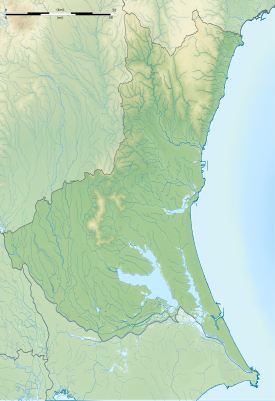Kasama Castle
| Kasama Castle | ||
|---|---|---|
|
Base of the castle tower |
||
| Creation time : | 13th Century | |
| Castle type : | Yamajiro (mountain castle) | |
| Conservation status: | Partly preserved | |
| Place: | Kasama | |
| Geographical location | 36 ° 22 '57 " N , 140 ° 15' 58.3" E | |
|
|
||
The castle Kasama ( Japanese 笠間城 , Kasama-jō ) is located in the town of Kasama in Ibaraki Prefecture . Most recently, a branch of the Makino resided there with an income of 80,000 koku as the larger Fudai daimyo .
Lords of the castle in the Edo period
- From 1601 the Matsui with 30,000 Koku,
- from 1608 a branch of the Ogasawara with 30,000 koku,
- from 1612 a branch of Toda with 30,000 koku,
- from 1617 a branch of the Nagai with 32,000 koku,
- from 1622 a branch of the Asano with 53,000 Koku,
- from 1645 a branch of the Inoue with 50,000 Koku,
- from 1692 a branch of the Honjō with 40,000 Koku,
- from 1694 again a branch of the Inoue with 50,000 Koku and
- from 1747 a branch of Makino with 80,000 koku.
history
In 1219, the Shioya Tokitomo ( 塩 谷 時 朝 ) belonging to the Utsunomiya clan is said to have built a castle on Mount Sashiro ( 差 白山 ) on the eastern edge of today's city of Kasama. When Toyotomi Hideyoshi fought against Odawara Castle in 1590, the lords of the castle at that time, the Kasama, vassals of the later Hōjō , went under. Then the Utsunomiya or the Gamō ruled there until a new era dawned with the Battle of Sekigahara .
Because of its proximity to Edo , the seat of the new Tokugawa Shogunate , the castle was occupied exclusively by princes loyal to Tokugawa - at first in rapid succession. In 1601 the Matsui Yasushige ( 松井 康 重 ; 1568–1640) received the castle, then it fell to the Ogasawara and so on, until the Makino received the castle in 1747 and remained there until the Meiji Restoration .
The attachment
Kasama Castle cleverly uses the natural features of Mount Sashiro, it is formed from different castle areas ( 曲 輪 , kuruwa ). The central area in which the two-story castle tower was located was protected by high stone walls. The entire complex represented a modernized form of a medieval mountain castle and is therefore an important contemporary document. - Later a sub-residence ( 下 屋 敷 , shimo-yashiki ) was built at the foot of the mountain on the western side , which has not been preserved, but is recognizable as a castle district.
Part of Mount Sashiro with the remains of the castle today forms a nature park supported by the prefecture ( 笠 間 県 立 自然 公園 , Kasama kenritsu shizen kōen ). The remains of the castle consist of the preserved part of the stone walls, the earth walls and the waterless ditches.
Some of the materials were used to build the Sashino shrine ( 佐志 能 神社 , Sashino-jinja ). The two-story Hachimandai watchtower was moved to the Shinjō-ji ( 真 浄 寺 ) further west of the city of Kasama as a "seven-sided hall" ( 七 面im ; Shichimen-dō ) .
Individual evidence
- ↑ a b c d Sugai, Yasuo: Kasama-jo in: Miura, Masayuki (ed.): Shiro to jinya. Tokoku-hen. Gakken, 2006. ISBN 978-4-05-604378-5 , p. 52.
literature
- Papinot, Edmond: Kasama . In: Historical and Geographical Dictionary of Japan. Reprinted by Tuttle, 1972 edition of 1910 edition. ISBN 0-8048-0996-8 .



